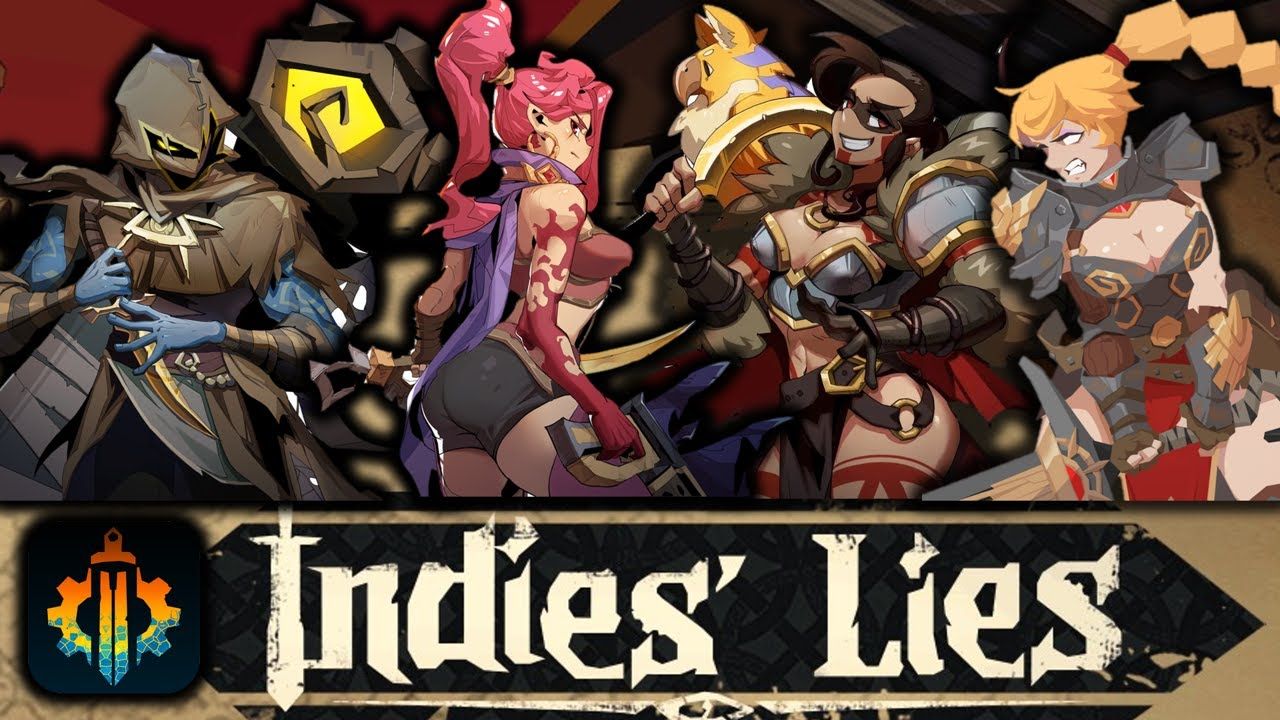Indies' Lies Review
Innovations in deck-building

I want to recommend Indies’ Lies. This roguelike deck-builder, developed by Fun Square Games, exists in the aftermath of Slay the Spire's wild success in popularizing the addicting formula created by the tabletop game Dominion in the digital space.
Indies’ Lies follows in the footsteps of its predecessors by creating thoughtful additions to the already excellent formula that expands on the game every card gamer knows and loves.
Classic Combat with a Twist
The turn-to-turn action is the same as it has always been. In combat, you draw a hand of cards that have abilities and energy costs associated with them, your energy determines how many cards out of your hand you can play per turn. The enemy creature has its turn intention telegraphed above its head to inform the player what they should be reacting against. You then have to decide the best way to mitigate incoming damage while dealing it at the same time; you do this until you or your opponent has their health drop to zero. Outside of combat, you are refining your deck by gaining, removing, and transforming cards.
Slay the Spire already does all of this at a high level, it’s the additions in complex systems and freedom of management that allow Indies’ Lies to reach new highs and lows that make this title such a hard game to judge.

Comic-Style Art and Animations
The first thing that I noticed about this game is how closely its art style and animations derive from Slay the Spire and I think that this only comes to the benefit of Indies’ Lies. The stylized storybook aesthetic has been warped to be more akin to a comic or cartoon which I know some people will really enjoy more as it gives the necessary visual character to differentiate the game's staggering nine-hero roster. Some of the heroes press the boundaries of my own taste via some overly well-endowed female cast, but even so, I like all twelve heroes' designs and think that they offer the player a good variety when it comes time to choose who your hero will be.
The animations are bare-bones but do their job effectively by highlighting attackers and selected cards. I wish that there was a bit more to accentuate the new complexities in the system but it just takes some getting used to before you know what to look for on each battle screen as a dozen passive and active abilities trade between combatants each turn. Outside of this, the UI is displayed on storybook pages that look neat and frame pertinent information really nicely, and each card pops really nicely as a result of this.
The 3D over-world looks at first a bit out of place but after a few runs it grew on me as an easy way to do at-a-glance path analysis to determine roughly where I wanted to go.

A Plethora of Characters and Playstyles
I mentioned that this game had nine characters (with an additional three including DLC), and those of you that played Slay the Spire might be frothing at the mouth at the idea of those options. Unfortunately, the truth to this is that the actual differences in gameplay between each character don’t stray all that much.
These twelve heroes are divided into four classes (Wizards, Rangers, Mechanists, and Knights in DLC) which hold the main differences in card acquisition. Your choice of character beyond choosing a class just dictates a specific play style inside of that class even though the same cards are presented to you regardless of which hero you choose. For example, in the Ranger class, there is a heat mechanic that has you balancing levels of heat to do insane amounts of damage. One character may start with a card that benefits from keeping your heat in a certain range while another may start with a card that benefits from maxing out your meter and overheating. You are swiftly given the option to switch out these cards and build your way but at the cost of the boon of your chosen hero. This sounds limiting, especially coming hot off of Slay the Spire where you are given the freedom to build a deck in any direction.
The bonus to the characters being separated more like this is that after each boss fight you are given the option to have one of the other characters join your team after defeating a boss. This means that you could potentially have a character from each class and craft a deck that works off of the bonuses of each class, something not possible in Slay the Spire as you are only playing as one character in that game. This system is hard to learn, taking in a new character with their own deck can be overwhelming your first time through a story. But practicing with characters in each class can make this much more manageable as you learn the strengths and weaknesses of each character.

A Storybook Lore Setup
The story of Indies’ Lies is half rooted in events that occur during the game and the character story presented to you through illustrated storybook pages. The characters' stories are fun peeks into their lives that only help to bring life to their personalities. The side stories and lore, however, are too disjointed and weighed down by mechanical choice to bear significance to most players.
But I want to believe that by design the game works this way. By encountering these events, the player is rewarded or punished with run-specific loot and then given permanent unlocks for their account when they’ve seen certain landmark events. The player wishing to dive headfirst into the world of Mekaa will find a lot to love in these interludes. However, most players will see these for what they are: a way to unlock things and gain run bonuses.
It makes me happy to see a game with a fun cast double down on their stories, it gives me an incentive to try each character to gain their unlocks and learn their story.

Mechanical Bugs and Nitpicks
There are some other problems that I have with Indies’ Lies, most of them are stemming from the fact that this game is dense and has to display a lot of information.
To start with some minor bugs, when I would recruit characters into my party, attack animations sometimes wouldn’t play. The damage still registered, so the game remains perfectly playable; this is just me picking on a little thing. Additionally, in the digital card game space, when a game uses keywords as a card ability, it has become customary to display the rule surrounding the keyword when highlighting a card. This game has that feature, but will occasionally leave out a keyword or two. Whether this is intentional or a technical bug, it can make choosing which card to put in your deck as a new player challenging. Even as an experienced player, it took me a while to know what the difference between Exhaust and Banish was; they sometimes were described when highlighting a rune that has them, which made rune forging a bit harder to understand.
I also have some issues with the way that card abilities and buffs are displayed to the player. There is a card called Collapse that reads “Deal Y damage X times (Y=number of cards in hand * 3)” and the cost of the card is X energy. When this card is placed in your hand, the first instance of Y is replaced by a number showing how much damage it will do. In the time between when I bought this card and when I first played it, I completely forgot about any text on it, so I was confused as to what Y was referencing. This could be easily remedied by keeping the card text the same but referencing the pointed value of Y in parentheses instead of replacing it. A few other cards have this issue as well, especially in the Alrayan Undertow DLC, where a few cards reference damage modifications and targets that aren’t listed on the card where the player can see them.
I want to express that all of these issues are visual and all of the cards react as intended when you play them, which means that any player can get used to these issues with time. I chose to bring it up because my background playing Magic the Gathering has made me cautious in making sure that all card descriptions clearly explain how a card is used to make sure players can make informed decisions during play, though this is more important when the game is physical.

Upgraded Customization Options
Indies’ Lies offers a lot of content and a lot of customization and freedoms that players used to this genre won’t be accustomed to. We have already covered how the choice of heroes offers more flexibility in build options rather than the expansion of unique play styles, but the next thing that you will notice is that there are a few different campaigns. Each campaign is the same length and gets randomized each time you enter but you may not notice a huge difference in each one other than a few battle backgrounds and the main boss of each area. There are some other things like enemy effects but these are less noticeable as you make your way through each scenario.
I think that this is fine, however, I would have liked to see a difference in over-world between each story. For example, a unique space can appear depending on which story you are playing. This game features the ability to replace cards, which is typically something that you have to jump through certain hoops to perform in other deck-builders. They balance this power by making the starting cards feed your heroes' unique mechanic, so even though you feel powerful in being able to tune your deck on a whim it may be a good idea to keep those “weak” cards that we are so used to scrapping in other games.
Ideas like this make the game feel like an evolution of its inspirations.

Indies Lies is Worth a Play
I’ve played a lot of deck-building games in the past few years and have honed in on certain aspects of the genre that are important to me. While there are a lot of things that make Indies’ Lies unapproachable to newcomers to the genre, there is a lot to love if players put in the time to learn its systems and characters.
Fun Square Games managed to create a game that changes the deck-building formula in ways that promote a focus on deck tuning and player choice. These kinds of improvements elevate the game past the reality of past games that could decide your victory on chance. If you are a fan of deck-building games then you owe it to yourself to try Indies’ Lies to see where the genre is headed in terms of game design, and if you have always wanted to pick up this type of game then I would suggest taking a step back to start with the classics. But anyone willing to learn Indies’ Lies is going to find a deep and rewarding roguelike with tons of lore and impressive combat.
Indies’ Lies was released from Steam Early Access on Jan 15th, 2023 on Steam and Mobile along with its first expansion, Alrayan Undertow.
